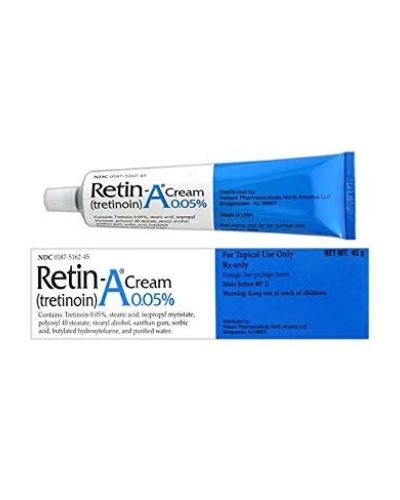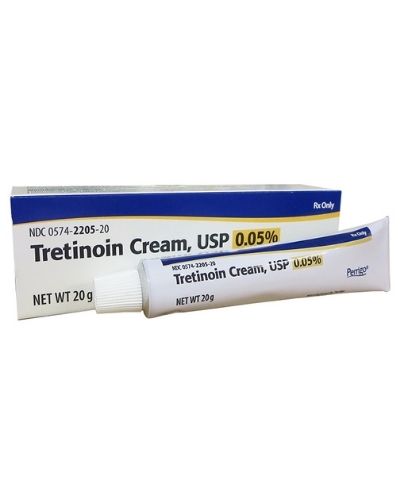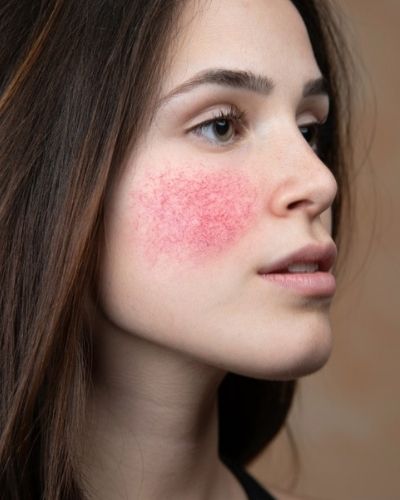If you’ve searched for information about treating acne or reducing wrinkles online, you’ve likely seen recommendations for two medications: tretinoin and Retin-A.
So, what’s the difference between the two? Is generic tretinoin as effective as Retin-A, or would you have to get the latter to target your skin concerns?
This article will explain everything you need to know about generic tretinoin and Retin-A and how different or similar the two are.

What is Tretinoin, and What are its Benefits?
Tretinoin, also known as all-trans retinoic acid, is an active form of vitamin A.
It is one of the most studied and research-backed ingredients in skincare products and works incredibly well to fix various skin concerns.
Some of the main benefits of using tretinoin are:
- Decreased lines and wrinkles.
- Improved hyperpigmentation and discoloration.
- Refined texture.
- Decreased sun damage.
- Reduced acne and clear skin.
RELATED: Beginners Guide to Tretinoin.
How is Tretinoin Different from Retin-A and Other Retinoids?

Tretinoin and Retin-A are the same thing. Tretinoin or all-trans retinoic acid is an active ingredient that’s sold as a generic topical medication for treating acne and skin aging.
Retin-A is just a brand name used to market a range of topical skincare medications that contain tretinoin.
Retin-A comes in cream or gel form and is manufactured by Bausch Health Companies Inc. It’s marketed specifically as a treatment for acne.
As a topical cream, Retin-A is available in a variety of different strengths, from the lowest 0.025% tretinoin, mid-strength 0.05%, to the strongest 0.1% tretinoin.
Retin-A topical gel, which is usually prescribed for oilier and coarse skins, is only available with 0.025% and 0.1% tretinoin.
Another version of Retin-A, called Retin-A Micro®, uses a microsphere formula and is available in 0.04%, 0.08%, and 0.1% strengths. This version is usually prescribed to people with extremely sensitive or rosacea-prone skin.
Generic tretinoin is sold under a variety of brand names. It’s available as a lotion, cream, and gel. Like brand name Retin-A, generic tretinoin comes in several strengths, from mild 0.025% up to 1%.
In addition to Retin-A, other brand names used for tretinoin include Altinac®, Altreno®, Atralin®, Avita®, Refissa®, Renova® and Tretin X®.
Tretinoin is also available in combination skincare products, such as Solage (which contains a combination of mequinol and tretinoin), Veltin® (clindamycin and tretinoin), Ziana® (clindamycin and tretinoin) and Tri-Luma (fluocinolone, hydroquinone, and tretinoin).
In addition to this, a few other brands are trying to make tretinoin easily available to those who can’t get it through insurance.
Some of them include Curology and Apostrophe in the US and Dermatica in Europe.
Whether marketed under a brand name or as a generic medication, all forms of tretinoin require a prescription.
Is Generic Tretinoin as Effective as Retin-A?
Since generic tretinoin and Retin-A contain the same active ingredient, neither is better than the other, and it all comes down to preference and availability.
If your healthcare provider prescribes Retin-A, your pharmacist may give you generic tretinoin. This is because, with a generic option, you’ll often pay less than you would for a brand-name drug.
But don’t think that generic medications are of lower quality or won’t work as well. All tretinoin products work in the same way by speeding cell turnover rate and keeping pores free from blockages.
Tretinoin medications also help soften fine lines, fade dark marks and discolorations, and leave your complexion looking brighter and feeling smoother.
RELATED: Does Tretinoin Work for Wrinkles?
Where Can You Buy Generic Tretinoin?

Any pharmacy sells some kind of tretinoin, be it generic or a brand name.
Therefore, the only thing you need to do to buy it is to book an appointment with your dermatologist and tell them that you are interested in using tretinoin.
They will give you a prescription, and you can then buy the product in any pharmacy in your location.
How Much Does Tretinoin Cost?
As I already mentioned above, all forms of tretinoin, whether marketed under a brand name or as a generic medication, require a prescription.
In the US, generic tretinoin is covered by most Medicare and insurance plans, but some pharmacy coupons or cash prices may be lower.
The lowest GoodRx price for the most common version of generic tretinoin is around $34, which is 79% less than the average retail price of $166 for Retin-A.
On the other hand, generic tretinoin isn’t covered by insurance in Europe; however, that’s probably because it only costs around $20 – $30, depending on your location.
What are the Side Effects of Tretinoin Use?

Although very efficient in improving acne, wrinkles, hyperpigmentation, and other signs of aging, tretinoin definitely comes with its own set of troubles, which is why it’s advisable to take it easy and give your skin extra care when starting out.
Here are the most common side effects of using tretinoin:
Dryness & irritation
Tretinoin works by speeding up the skin cell turnover cycle, ridding of the old layer of skin faster than usual.
This causes your skin to become dry and flakey as your skin purges and peels to become accustomed to the retinoid.
RELATED: How to Fix Dry Skin From Tretinoin?
Peeling
Peeling and shedding is another common side effect caused by the increased skin cell turnover cycle.
The skin usually peels the most around the mouth, but this unwanted occurrence can develop in any areas where tretinoin is used.
It’s also very important to thoroughly wash tretinoin off your fingers and hands after applying it, as it will also cause these areas to peel, too.
Increased sun sensitivity
As your skin adapts to tretinoin, it will likely become more sensitive to the sun.
This happens because the rapid cell shedding will somewhat incapacitate the skin to protect itself from the sun, which is why you will start experiencing sunburns much quicker than it took you to experience them before starting tretinoin.
This is why wearing sunscreen is absolutely crucial while using tretinoin because the sun damage on the skin has the potential to be even more severe while the skin is vulnerable due to tretinoin.
So if you are experiencing a sudden warmth on your face, even if it’s not that hot outside, it’s a sign that your tretinoin is working and that you need to apply sunscreen ASAP.
RELATED: Best Sunscreens To Use While On Accutane.
Purging
As tretinoin works by speeding up cellular turnover, this action will push all those dead skin cells that didn’t shed properly and remained inside the pore, mixing with skin oil and causing clogs that led to acne in the first place, to the surface of the skin.
So what will happen when you start using tretinoin is your skin will basically purge all those clogs to the surface and turn them into pimples so that they can heal and disappear.
And because all of them will come out on the surface at the same time, instead of popping up as one or two pimples every few days or weeks, it will definitely look scary, but it is actually a good thing.
Lastly, while a purge usually lasts anywhere from 8-12 weeks, it’s not uncommon for it to stick around even up to six months or a year, especially if you are using skincare or makeup products that are continuing to clog your pores, because this way tretinoin will just continue to purge the clogs.
This is unlikely to happen to someone whose skin isn’t prone to acne, and if it does, it would usually be something mild.
However, since tretinoin is often prescribed to people whose skin is prone to acne, the purging stage is likely to be more intense in these cases.
Who Shouldn’t Use Tretinoin and Why?
Tretinoin is a powerful medication that speeds up the cell turnover rate, and it can be useful for all skin types and ages.
Your dermatologist will determine which strength would you need depending on your skin type, the current state of your skin, and concerns you want to address; therefore, tretinoin is definitely safe to be used by anyone.
The only instance in which you shouldn’t use tretinoin is during pregnancy.
Much of the concern about tretinoin is because it’s related to isotretinoin (also known as Accutane,) a medication known to cause birth defects involving the face, heart, and brain.
However, isotretinoin is taken by mouth, and easily enters the bloodstream in relatively large amounts, and can then reach the developing baby.
Tretinoin, on the other hand, is topically applied, and while it’s unlikely to cause birth defects, there aren’t studies that confirm it’s safe to use during pregnancy, so i’s best to avoid it during this time.

My name is Simone and I am a certified skin specialist. I created this website to teach my readers how to take great care of their skin and I also like to occasionally share my honest opinions on skincare products I’ve tried. You can learn more about me here.
